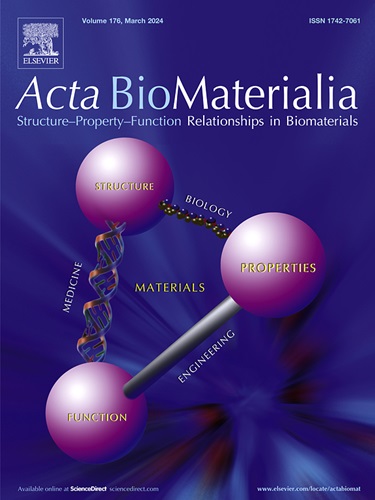Regenerated fat induced by a decellularized adipose matrix can survive long-term in vivo
IF 9.4
1区 医学
Q1 ENGINEERING, BIOMEDICAL
引用次数: 0
Abstract
Decellularized adipose matrix (DAM) is considered to be the most potential biological scaffold for soft tissue repair and reconstruction, as it is able to induce the regeneration of adipose tissue in situ in adulthood. But how does this adipose tissue regeneration happen and develop in vivo? Is it the same as the original autologous one? Temporary existence or long-term survival? These are the key questions that will determine the future applications of DAM. In this study, we investigated the composition, structure and biomechanical properties of DAM before implanting it into the subcutaneous back of immunodeficient mice. The entire regeneration process in vivo was closely monitored histologically from 3 days to 1 year after implantation, including fat regeneration, vascular growth, inflammatory responses, and matrix degradation and remodeling. Transcriptome sequencing was used to analyze the difference in gene expression between regenerated fat and autologous fat at different periods. The results showed that the DAM-induced regenerated fat first appeared at 1 w and remained stable over 6 m, indicating remarkable similarity to autologous fat at the later stages of implantation. And about (18.3 ± 29.3) % of the regenerated adipocytes were still viable after one year. The process of adipogenesis was enhanced by the decrease in inflammatory infiltration and proceeded in parallel with angiogenesis.
Statement of significance
The decellularized adipose matrix (DAM) is the only biological scaffold that can spontaneously generate adipocytes in vivo without the need to add exogenous cells. However, in the previous studies, the longest DAM-related animal experiments were about 3 months. The different stages and characteristics of DAM implantation cannot be fully captured. Comprehensive preclinical researches on the initiation, characteristics, and long-term outcomes of DAM-induced adipose tissue regeneration in adulthood is crucial.
In this study, we closely observed various aspects of the entire process in vivo from 3 days to 1 year after implantation including fat regeneration, vascular growth, inflammatory reactions as well as matrix degradation and remodeling. The thorough research will contribute to the understanding of stability and dynamic remodeling of DAM regeneration models.

脱细胞脂肪基质诱导的再生脂肪可在体内长期存活
脱细胞脂肪基质(DAM)被认为是最有潜力用于软组织修复和重建的生物支架,因为它能够诱导成年期脂肪组织的原位再生。但这种脂肪组织再生是如何在体内发生和发展的呢?它与原来的自体脂肪组织一样吗?是暂时存在还是长期存活?这些都是决定 DAM 未来应用的关键问题。在本研究中,我们在将 DAM 植入免疫缺陷小鼠的皮下背部之前,对其成分、结构和生物力学特性进行了研究。从植入后 3 天到 1 年,我们对体内的整个再生过程进行了密切的组织学监测,包括脂肪再生、血管生长、炎症反应以及基质降解和重塑。转录组测序用于分析再生脂肪和自体脂肪在不同时期基因表达的差异。结果显示,DAM诱导的再生脂肪在1w时首次出现,并在6m内保持稳定,表明在植入后期与自体脂肪非常相似。一年后,约(18.3 ± 29.3)%的再生脂肪细胞仍然存活。由于炎症浸润的减少,脂肪生成过程得到加强,并与血管生成同步进行。意义说明脱细胞脂肪基质(DAM)是唯一一种无需添加外源细胞即可在体内自发生成脂肪细胞的生物支架。然而,在以往的研究中,与 DAM 相关的动物实验时间最长约为 3 个月。DAM 植入的不同阶段和特征无法完全捕捉。对 DAM 诱导的成年期脂肪组织再生的起始阶段、特征和长期结果进行全面的临床前研究至关重要。在这项研究中,我们密切观察了植入后 3 天到 1 年的体内全过程的各个方面,包括脂肪再生、血管生长、炎症反应以及基质降解和重塑。这项深入研究将有助于了解 DAM 再生模型的稳定性和动态重塑。
本文章由计算机程序翻译,如有差异,请以英文原文为准。
求助全文
约1分钟内获得全文
求助全文
来源期刊

Acta Biomaterialia
工程技术-材料科学:生物材料
CiteScore
16.80
自引率
3.10%
发文量
776
审稿时长
30 days
期刊介绍:
Acta Biomaterialia is a monthly peer-reviewed scientific journal published by Elsevier. The journal was established in January 2005. The editor-in-chief is W.R. Wagner (University of Pittsburgh). The journal covers research in biomaterials science, including the interrelationship of biomaterial structure and function from macroscale to nanoscale. Topical coverage includes biomedical and biocompatible materials.
 求助内容:
求助内容: 应助结果提醒方式:
应助结果提醒方式:


